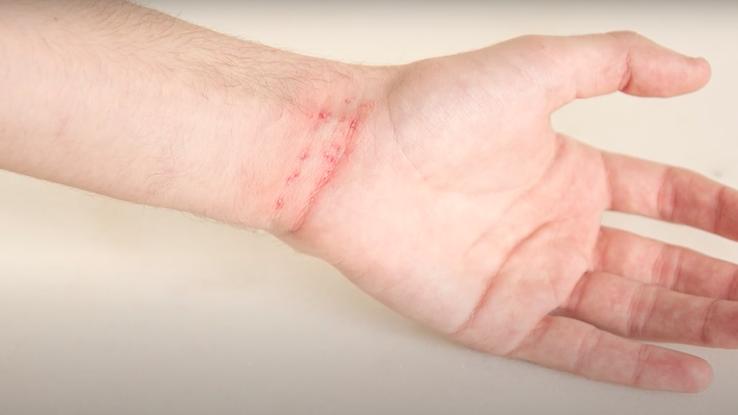
Scabies is a skin condition that can feel unpleasant and cause you some discomfort, but it usually isn’t a serious issue that requires emergency treatment. It’s common all around the world, and because it can spread quickly, you or someone you know may have this condition or have had it before. If you’re concerned that you may have contracted scabies or have come into contact with someone who does, learn more about what this condition is and what you can expect from treatment.
What Is Scabies?
Scabies isn’t a disease or an illness. Instead, it’s an infestation. It happens when tiny mites, which are related to ticks and spiders, called Sarcoptes scabiei burrow into your skin. After creating burrows, the mites travel into your skin and lay eggs inside. The mites continue to live there, and as the eggs hatch, new mites travel to other areas of your skin and create more burrows.
A more severe form of scabies, called crusted scabies, develops when an infestation causes a person to develop large, crusty patches of skin that contain much higher numbers of mites and eggs than a typical case of scabies. This form usually affects people who are immunocompromised, disabled or elderly.
Scabies spreads quickly among people, particularly when they’re in close contact with one another in settings like daycares or nursing homes. It often results from prolonged skin-to-skin contact with an infested person, such as during sexual intercourse. However, it’s also possible to acquire an infestation by coming into contact with clothing, bedding, towels or other fabrics that an infested person has used. It’s less common to acquire scabies from infested fabrics unless a person with crusted scabies has been using or wearing them.
Symptoms of Scabies
Scabies typically causes a skin rash that’s extremely itchy. The rash can form small bumps that look like pimples, but it may also create scale-like patches on your skin. Scabies can feel itchy all the time, but many people who’ve had this condition report that the itchiness worsens severely at night. This sensation isn’t due to the biting or burrowing, but to an allergic reaction caused by the mites’ feces and to protein allergens in the mites’ bodies.
Itching can be particularly bad in areas of your body where there are folds or skin-to-skin contact, such as your elbows and armpits or the webbing between your fingers. However, people who have scabies also find that the itchiness and rash commonly appear on their buttocks, waistlines, wrists and shoulder blades.
Crusted scabies doesn’t usually cause a rash or itching. Instead, sometimes the only symptom is the thick, crusty patches of skin it creates.
Getting Treatment for Scabies
It’s likely that your doctor will be able to diagnose scabies by doing a visual inspection of the rash and asking about your symptoms. Scabies often leaves a distinctive rash with a sore near a mite’s entry spot that has a visible trail leading away from the sore, which is the mite’s burrow tunnel. Your doctor may want to confirm the diagnosis with a skin scraping. This is a testing procedure that involves your physician using a scalpel to scrape away some of the dead top layers of your skin and examining them under a microscope to look for the presence of dead mites, mite eggs or mite feces.
Once your physician has confirmed the diagnosis, you’ll start treatment immediately. Because scabies spreads so quickly, doctors often prefer to treat it aggressively to get rid of infestations as fast as possible. Your physician will likely prescribe a scabicide, which is a type of medicine that kills the mites. Some scabicides also kill mite eggs. These medications are typically available as creams or lotions, and you’ll apply them to your entire body from your neck down to between your toes. Depending on the instructions included with the scabicide, you may need to wait a specific length of time before rinsing the medicated cream off your body.
If any of the scabies sores become red, swollen or warm to the touch due to scratching or another reason, you may have an infection. Let your doctor know. They may prescribe an antibiotic to clear up the infection.
Scabies Prevention
Scabies can cause you discomfort, which is just one important reason why you’ll want to work to prevent an infestation. Another good reason? Because symptoms can take two months to appear before you realize you’re experiencing an infestation for the first time, it’s possible to transmit the mites to other people without realizing it. Prevention starts with avoiding contact with people you know have an infestation, if possible. If you live in a house with someone who’s diagnosed with a scabies infestation, even if you don’t have symptoms or think you have it, your doctor may also recommend that you undergo preventative treatment with medication.
Fortunately, scabies mites don’t usually live longer than two or three days outside of human skin. Once you’ve begun treatment or someone in your household has, immediately wash all clothing and bedding they touched during the three or four days prior to starting treatment. Use the hottest settings on your washer and dryer, or have the items dry cleaned if you’re unable to wash them yourself. If it’s not possible to wash items yourself or have them dry cleaned, you can bag them up and store them, unused, for about a week, which gives the mites time to die off. Vacuum all furniture and floors where an infested person has spent time, and wait at least three days to have contact with upholstered surfaces again.
Resource Links:
https://www.mayoclinic.org/diseases-conditions/scabies/symptoms-causes/syc-20377378
https://www.cdc.gov/parasites/scabies/index.html
https://medlineplus.gov/scabies.html
https://www.cdc.gov/parasites/scabies/disease.html
https://www.cdc.gov/parasites/scabies/diagnosis.html
https://www.learnskin.com/articles/skin-scraping-koh-and-mineral-oil-preparation





